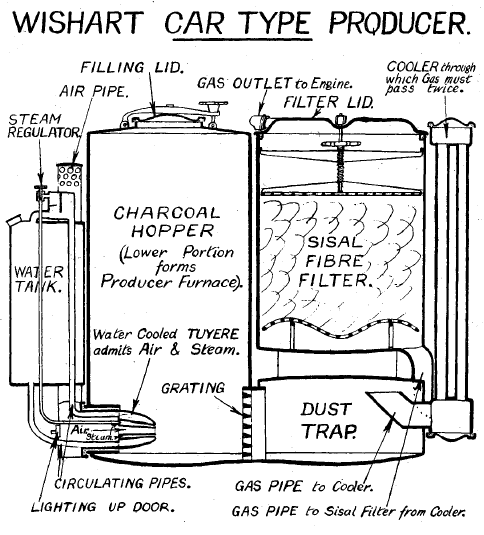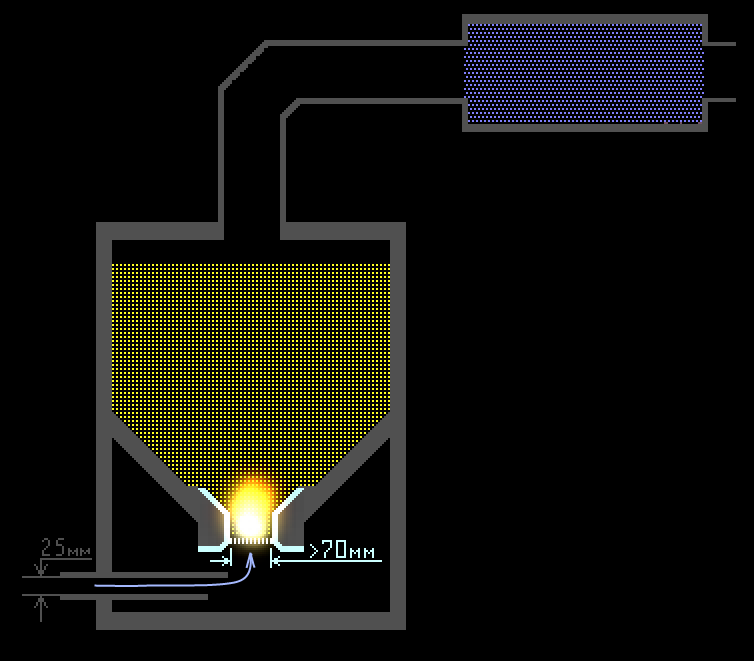Dave,
I just have the thermocouple lying in the nozzle with the sensor end by the nozzle opening. See the picture looking into the nozzle on my first test above. I got this 12" long ceramic double element probe at a surplus electronics store. The meter is a cheapo from ebay. I also have stainless steel probes that work OK as long as the are not directly in the reaction zone.
Thanks Bruce ,
I think I can just about make out a white hot tip inside of the tube .
Ok I decided its been so long since I had seen my nozzle that I have just opened up the hatch to take a look in side , rusted in bolts on the hatch cover took some moving but got there in the end , i don’t think I will leave it so long next time, or maybe i will cover it from the rain .
I think my inspection timing was more or less perfect one more week longer and I don’t think there would be much left to inspect !
Here are the photo’s starting with how it would have looked before I installed it , I am just going to replace it with another of the same type .
And from that to this … 3 months later
All in all I am pretty pleased really considering the run times I have given it since installing it 3 months ago .
Dave
Dave,
If I have followed this correctly, three months is between 150-200 hours? At what average load?
Please remind us here of the load and duration so we can find them listed with these great pictures. Thanks for this simple and practical nozzle design.
Are you still planning to try a Kristijan-style thick walled steel nozzle?
Hi Bruce ,
as always I make a mess of logging all my run times due to doing too many things at once , but on average I had run this around 3 or 4 times a week since Aug 20th for about 4 hours a day .
So I would rather guess lower at around 150 hours running time , the loads are mixed from my small engine running a 28 amp 24 volt generator and a 9hp running a 12 volt 40amp car alternator , to my inverter generators that are charging up my larger 24v battery packs at around 50 amps while using a 1500 watts chop saw on mains 240 volt .
I do intend on putting the stainless tube back in, the one with the 2 vertical 12mm holes and run that again till destruction , from memory it already has about 80 hours on it and looked in good shape for more runs when I took it out 3 months ago .
If I can get my hands on some thick walled steel pipe I shall try that as well as Kistijan had really good results with his one .
Dave
What do you think of using the Al or Pb fusion to open or close the EGR pipeline of a gasifier?
If the EGR pipe plunges into an Al bath (similar to a siphon) and this bath is close to the heat of the gasifier.
The Al will melt and freeze (opens and closes EGR) (= temperature control of the hearth)
I hope to be understood.
Thierry
Probably unnecessary for EGR since EGR is self-regulating, but maybe good for water drip/steam? Maybe use tin since it melts at 230C/450F?
Hi all, The water cooled nozzle got a two hour work out yesterday. I am very pleased with how well it stood up. No engine exhaust or fluid drip was used to cool down the combustion zone. The engine was a Predator 2500watt generator that did not pull very hard on the gasifier, However I still feel a larger engine still would not affect the nozzle. The nozzle is made from a 1"copper pipe enclosed inside a 1 1/2" copper pipe. This annular space is filled with water to carry the heat away. The hot water rises through a pipe and percolates into a resivour. At the bottom of the resivour is a pipe to return the cold water to the nozzle. Here are a few pictures.
Gary from PA
Gary, you’r a genius…
Gary, that looks a lot like the picture I had in my head. I’ m glad you tried it first since I wasn’t that keen to buy the large diameter copper.
I wondered too if you could run the nozzle all the way through to extend out both sides of the bucket?
I love your new Tea brewer!
If you create a water inlet half way up the side of the reservoir for the return pipe, the system will be full of water and will flow as a thermosyphon which may remove more heat than the percolation method. Admitting the hot water half way up allows the hot water to rise into the tank creating a better flow than entering near the top. At least that is the way it is done for domestic hot water systems. However, you may be producing so much steam that it makes little difference?
Tapping the steam from your percolator pipe as in the Wishart diagram also looks like a promising addition.
Thank you for creating and sharing this great nozzle setup!
Based on Gary’s slotted pipe

i have started thinking about this idea ( short clip )
Actuating the plunger with either vacuum from the inside gasifier ( no vacuum : slot is closed )
or with an external mechanical actuator evt with solenoid/servo control
Koen,
Very clever. Perhaps use a nozzle tube that passes through both sides of the reactor body and use a solid rod as the moving valve. The rod would be less likely to corrode than another tube. A stud could be added to the internal rod so that it serves as a clinker cleaner. If the slot was made longer, this stud could be located on the rod back a bit from the reaction zone.
Hi Bruce,
Thats a good idea to install some “clinker cleaning” studs.
The whole idea is based on all the efforts combined from what i have seen here in this thread, also from your experiences.
I am looking forward to find the material to build it and test it 
I know I am jumping into the middle of this one, but all of us blacksmiths have “clinker breakers” in our forges.
I even have an unique firepot from the Czech republic that grinds the clinker into dust so it can fall out the bottom through a lever-controlled gate.
See:
http://spaco.org/Blacksmithing/Pictures/MiscellaneousPictures.htm
Pete Stanaitis
Hi Pete,
Reminds me of Don’s charcoal reactor on his Geo Tracker:

Dear Lord!!! After I read Your topic in which the chief one, I became a Professor of engineering Science and as a Physicist can talk on the subject: the higher the temperature in the combustion zone of the reactor, the thinner may be a layer of burning and it needs to be thinner, so the reaction happen instantly. You make a big mistake when in direct gasifier trying to use a reactor of large diameter. For Your purposes the diameter of the reactor should be value = 70-90 mm., and then to expand into the hopper through the cone shape. Thus, it is not necessary to draw air through a single tuyere. Down through the pad holes, as shown in the beginning of the topic, thus You rassredotochit tension over a greater area and remove the tension from the metal tuyere. Don’t try to do as in the transverse-horizontal gas Generator, is a mistake. You need to use a long recovery zone for direct gas Generator, which is situated above the combustion zone in the reactor and the air velocity through the reactor should be lower in comparison with the velocity through the reactor and the transverse-horizontal gas generator. If you run after two hares, will not work and the system will not work correctly. For control of Generator use thick copper tuyere, water-cooled, to hundreds of hours of work, not a moment. Why suffer with a transverse scheme of the gas generator? Understand this secret!!! I always in the sky looking at You.
It is necessary to do on the principle of George Adams:

Care to specify which posts you are referring to? This topic is 300 entries long and I’m trying to place your comments accordingly.
Best regards, David Baillie
To melt, the lance will not. The cold gas at the exit of the bunker. This is the main superiority of the direct gasifier charcoal as fuel for small power internal combustion engine = < 10 HP.











